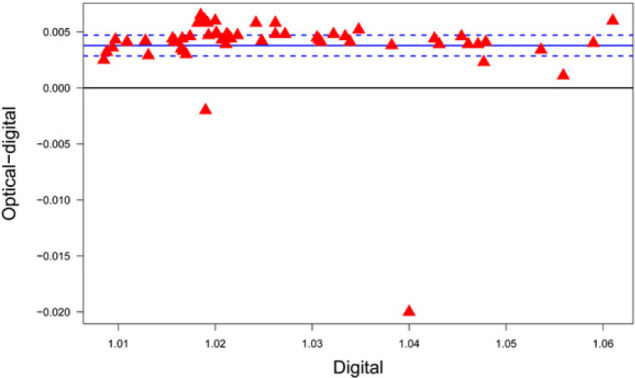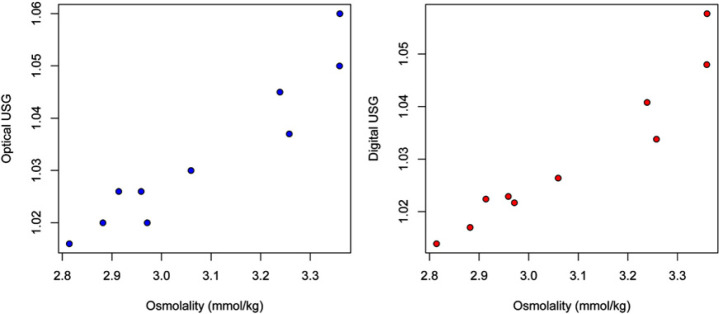Abstract
Measuring urine specific gravity (USG) is an important component of urine analysis as it evaluates renal concentrating capability. The objective of this study was to quantify the difference in USG values between a hand-held optical analogue refractometer and a cat-specific digital instrument. Urine samples from 55 cats were assessed. There was a statistically significant difference between these two refractometers (P<0.001), with the optical refractometer (mean USG=1.031) consistently reading higher than the digital refractometer (mean USG=1.027). Results for a random subset of the samples (n=10) were compared with urine osmolality and both the optical and digital instruments demonstrated excellent correlation. While an accurate USG reading is important, it is unlikely that the statistical significance between the two instruments is clinically significant and, therefore, unlikely to result in a change in patient evaluation or treatment plans. While both the digital and optimal refractometers are highly correlated to the urine osmolality, making both devices valid for assessment of USG in clinical practice, this digital device is easier to read and eliminates the variability of subjective interpretation.
Urine specific gravity (USG) is an essential measurement used regularly when diagnosing and treating patients in veterinary medicine. However, there are few feline-specific studies. The gold standard in veterinary medicine when evaluating urine concentration is urine osmolality. However, the necessary equipment is expensive and not routinely found in clinical practice. USG closely correlates to urine osmolality and has been accepted as an accurate clinical measure of renal concentrating ability. 1–4
In clinical practice, USG is measured most often by refractometry. The aim of this study was to assess the standard of agreement between USG measurements taken from a digital and an analogue optical hand-held refractometer. It was hypothesised that because the digital instrument is specifically calibrated for feline samples, it would give more accurate measurements of USG.
This study evaluated feline USG with two different instruments. Urine samples were collected as voided samples or via cystocentesis from hospitalised patients at the Hospital for Small Animals at the Royal (Dick) School of Veterinary Studies between January and June 2009. Where samples were collected via cystocentesis the procedure was performed because of clinical need and the remnant sample was used in this study. The samples (each of 5–10 ml of urine) were stored in closed universal collection tubes at 4°C until the analysis was completed in mass. Urine samples from 55 cats were evaluated. Each sample was analysed using the Palm Abbe Vetmed Digital Refractometer (MISCO, Cleveland, OH) (digital refractometer) and the RHCN-200ATC traditional analog hand-held refractometer (NCCLS, Wayne Pennsylvania) (optical refractometer). The samples were brought to room temperature prior to analysis. Each sample was assessed simultaneously on the two devices. Two drops of urine were placed on the digital refractometer and the sample was analysed under the ‘cat’ calibration setting. The same amount of urine was used when evaluating the samples with the optical refractometer. Both instruments were cleaned after every sample and zeroed in five sample intervals. All samples were evaluated using the optical refractometer by one author (GEM) to minimise inter-reader variability. A paired Student's t-test was performed to assess whether or not there was any significant difference between the measurements obtained from the digital versus the optical refractometer.
The statistical analysis was carried out using S-Plus (version 6.2.1, 1988, 2003 Insightful Corporation S: Copyright Lucent Technologies). A P value <0.05 was taken as demonstrating statistical significance. The Bland–Altman analysis was used to assess the level of agreement between the two devices. In addition, osmolality was measured on 10 randomly selected samples using a freezing point depression osmometer (Advanced Instruments, Norwood, MA, USA). The results of this were compared to both the digital and optical readings and the correlation assessed using Pearson's correlation coefficient; again a P value of <0.05 was taken as demonstrating statistical significance.
There was a statistically significant difference between the two refractometers (P<0.001), with the optical refractometer (mean=1.031) consistently reading higher than the digital refractometer (mean=1.027), with a mean difference of 0.0034 (95% confidence interval (95% CI): 0.0028–0.0047) and demonstrated by the Bland–Altman plot shown in Fig 1. 5
Fig 1.

Bland–Altman plot of the difference between the optical and the digital refractometers against the specific gravity assessed by the optical refractometer. The solid blue line represents the mean difference, and the dashed lines the 95% CI.
Analysis of the refractometer readings was compared to the urine osmolality in a random selection of 10 samples. The readings from both the digital and optical refractometers showed excellent correlation with the osmolality results (Fig 2 and r=0.967 (95% CI 0.861–0.992) and 0.960 (95% CI 0.834–0.991), respectively).
Fig 2.
The correlation between refractometer measurements and osmolality. Optical; optical refractometer measurement of urine specific gravity, digital; digital refractometer measurement of urine specific gravity, osmolality (mmol/kg).
Urine from cats differs from human and canine urine as USG readings of feline urine measured on a refractometer designed for humans yields falsely elevated values. 1,3 Refractometer scales are based on experimental data from normal human urine, and refractometric measurements of USG from human samples have been closely correlated to osmolality. 1,3,6–9 Similar conclusions have been assumed for canine samples based on instrument protocols and usage. 3,6–9 In contrast, feline samples have consistently higher relative refractivity than either human or canine samples. 1,3,6 While it is not known why this occurs it may relate to the fact that refractometers do not measure USG directly: they measure the angle of refraction (bending) of light as it passes between air and an aqueous solution. 3 Feline urine may, therefore, contain a substance that interferes with this process but does not affect the osmolality. It has been suggested that this may relate to their high protein diet. 3 A conversion calculation is available: feline USG=(0.846×refractometer SG)+0.154, which is based on data from 1956. 1,3 To take this phenomenon into account this digital refractometer has been calibrated to refractive index reference standards that are traceable to the US National Institute of Standards (NIST) and the internal scale is programmed with a mathematical representation of the relationship between feline USG and refractive index (personal communication, Michael Rainer, MISCO, USA).
An accurate USG reading is clinically important. For example, feline lower urinary tract disease can be caused by a number of different conditions, but feline idiopathic cystitis is the most common. A reduction in USG can have a palliative role in this condition, and having a reliable method to assess USG is important to accurately track changes associated to this treatment goal. 10,11 This can also have a positive influence on owner compliance by providing objective feedback to their efforts to reduce their cats USG.
This study revealed a statistically significant difference between the USG values gained from the two hand-held refractometers. However, the difference is not believed to be clinically significant as the mean difference between the digital and optical refractometers was only 0.0034. While the mean USG from this particular traditional analog optical refractometer was 1.031, application of the feline conversion calculation gives a mean USG of 1.026, which is similar to the mean USG of 1.027 gained from the digital refractometer. 8 Practically, the small difference between the USG gained using the two devices is unlikely to change either the clinical evaluation of the patient or alter a treatment plan.
The Bland–Altman chart in Fig 2 highlights the difference in readings between the optical and digital instruments. While quality control measures were in place to preserve the integrity of the data, limitations of this study were the limited preparation of the samples, the storage of the samples and, in the case of the optical instrument, human interpretation of the refractometer's findings. There are two outliers that we believe to be spurious results. As the samples were not centrifuged, it is possible that these may have resulted from variation in the content of suspended components (such as proteins or perhaps crystals) in the portions of the sample that were assessed by the two different devices. 2 In retrospect, it would have been better to have centrifuged and possibly frozen the samples.
In conclusion, this study showed that the USG determined by both the optical or digital refractometers correlated well with osmolality. However, the USG measurement from the optical refractometer was 0.0034 higher than those for the digital refractometer. It is, therefore, best to consistently use the same type of instrument when measuring USG in cats.
Acknowledgments
Dr D J Shaw gave advice on the statistical analysis. KES's and AMS's posts are sponsored by the Feline Advisory Bureau, and GEM was supported by a Nuffield Science Bursary.
References
- 1.Rubini M.E., Wolf A.V. Refractometric determination of total solids and water of serum and urine, J Biol Chem 225, 1956, 869–876. [PubMed] [Google Scholar]
- 2.Chadha V., Garg U., Alon U. Measurement of urinary concentration: a critical appraisal of methodologies, Pediatr Nephrol 16, 2001, 374–382. [DOI] [PubMed] [Google Scholar]
- 3.George J.W. The usefulness and limitations of hand-held refractometers in veterinary laboratory medicine: an historical and technical review, Vet Clin Pathol 30, 2001, 201–210. [DOI] [PubMed] [Google Scholar]
- 4.Lees G.E. Early diagnosis of renal disease and renal failure, Vet Clin North Am Small Anim Pract 34, 2004, 867–885. [DOI] [PubMed] [Google Scholar]
- 5.Altman D.G., Bland J.M. The statistician, J R Stat Soc Ser D 32, 1983, 307–317. [Google Scholar]
- 6.Wolf A.V., Pillay V.K. Renal concentration tests; osmotic pressure, specific gravity, refraction and electrical conductivity compared, Am J Med 46, 1969, 837–843. [DOI] [PubMed] [Google Scholar]
- 7.Dorizzi R., Pradella M., Bertoldo S., Rigolin F. Refractometry, test strip, and osmometry compared as measures of relative density of urine, Clin Chem 33, 1987, 190. [PubMed] [Google Scholar]
- 8.Leech S., Penney M.D. Correlation of specific gravity and osmolality of urine in neonates and adults, Arch Dis Child 62, 1987, 671–673. [DOI] [PMC free article] [PubMed] [Google Scholar]
- 9.Dossin O., Germain C., Braun J.P. Comparison of the techniques of evaluation of urine dilution/concentration in the dog, J Vet Med Assoc 50, 2003, 322–325. [DOI] [PubMed] [Google Scholar]
- 10.Gunn-Moore D.A., Shenoy C.M. Oral glucosamine and the management of feline idiopathic cystitis, J Feline Med Surg 6, 2004, 219–225. [DOI] [PMC free article] [PubMed] [Google Scholar]
- 11.Markwell P.J., Buffington C.A.T., Chew D.J., Kendell M.S., Harte J.G., DiBartola S.P. Clinical evaluation of commercially available urinary acidification diets in the management of idiopathic cystitis in cats, J Am Vet Med Assoc 214, 1999, 361–365. [PubMed] [Google Scholar]



